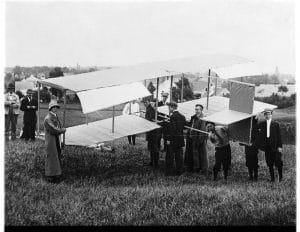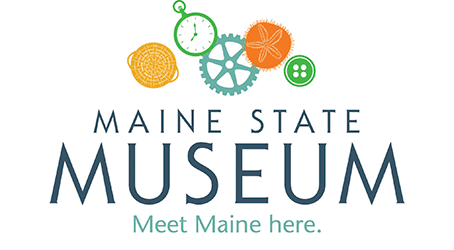
Learn
Meet Maine here.
Learn
Meet Maine here.
Make your own glider out of paper
Soaring Imagination
On December 17, 1903, the Wright brothers became the first humans to fly a plane that was heavier than air, and public imagination soared. Kids dreamed about flying and made model planes. In 1911, seventeen-year-old Harold Cooper of Auburn, Maine took his imagination a step further and built a full-sized glider that actually flew. He made his glider of common-place materials such as pine, piano wire, and cotton sheeting.
 Harold was too heavy to fly the glider, so he talked eleven-year-old Phillip Tarr into being the pilot. In the summer of 1912, with Tarr hanging on by his elbows, the glider flew 100 feet and as high as 30 feet in the air.
Harold was too heavy to fly the glider, so he talked eleven-year-old Phillip Tarr into being the pilot. In the summer of 1912, with Tarr hanging on by his elbows, the glider flew 100 feet and as high as 30 feet in the air.
The Lewiston Journal photograph above shows the event. According to family members, Harold may be the tall boy in the “cockpit” of the glider. The boy peering from under the tail may be Phillip Tarr, who flew the plane. The glider flew in an area called the Cradles in the Sullivanville section of Auburn.
Harold Cooper became a mechanical engineer, working for area shoe manufacturers. He later purchased Woodworth’s Machine Shoe Company in Lewiston. Harold married Phillip Tarr’s older sister, Esther, and they had four children.
Make your own glider out of paper!
Try out one or all of the seven paper airplane designs found here and test your flying skills! Some of these designs are easy to make; others are a bit more challenging and require a ruler or scissors.
- Basic Dart Guide
- Heavy Nosed Plane Guide
- Hunting Flight Plane Guide
- Phoenix Plane Guide
- Stunt Plane Guide
- The Soaring Eagle Guide
- The UFO Guide
How does your paper airplane fly?
Airplanes use lift and thrust against their weight and drag to fly.
Lift is the upward force required to overcome gravity. Lift is created when the air below the airplane wing is pushing up harder than the air above it is pushing down. The wings of a plane are usually curved slightly so that the air can move more quickly over the top of the wing than the air moves below the wing. This creates an upward push on the wing, which generates lift.
What happens if you slightly curve the wings of your paper airplane?
Thrust is the forward motion of a plane. For full-size airplanes, the engine is what generates the thrust. For paper airplanes, thrust is created by the forward launch of the thrower’s arm.
Does your plane travel farther when you throw it straight, like a dart? Or with an arc?
Drag is something that slows us down. Drag occurs when air resists the forward motion of the plane. Many factors affect the amount of drag. The shape of the paper airplane is one of them. To reduce drag and allow the plane to fly as far as possible, you want a plane design that creates as little drag as possible and moves through the air smoothly.
Which plane design flies best? Why do you think that is?

